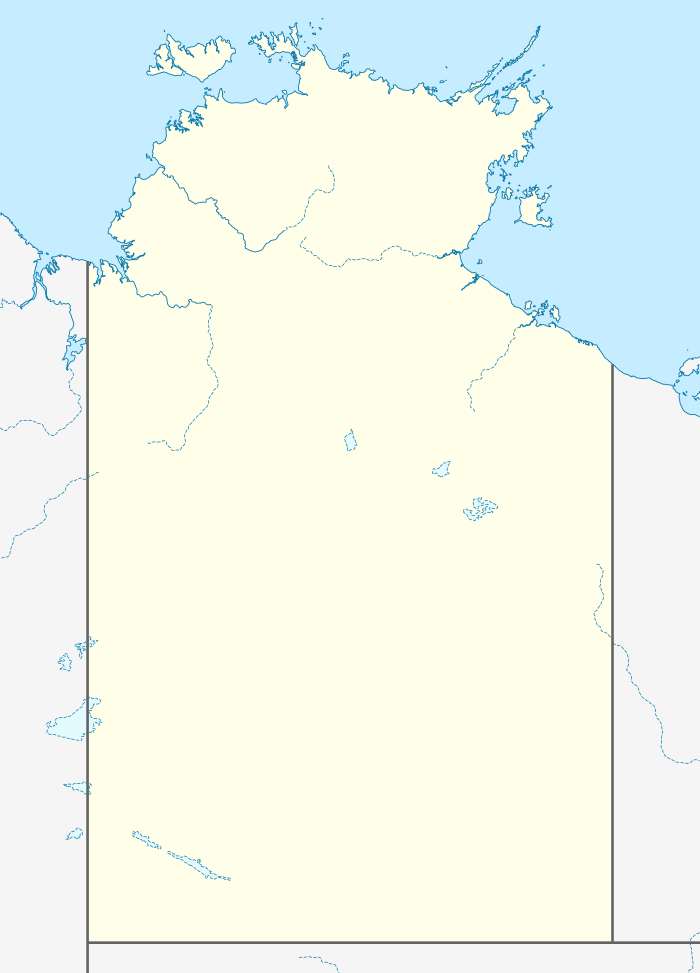Anthony Lagoon

Coordinates: 17°58′41″S 135°31′59″E / 17.978°S 135.533°E
Anthony Lagoon is a cattle station on the Barkly Tableland in the Northern Territory, Australia. It is situated approximately 215 kilometres (134 mi) east of Elliott and 227 kilometres (141 mi) south of Borroloola.
Description
The Station when combined with neighbouring Eva Downs occupies an area of 9,349 square kilometres (3,610 sq mi) and has a carrying capacity of approximately 60,000 head of Brahman cattle.[1] Eva Downs is run as an outstation of Anthony Lagoon and employs a separate manager, but is still part of the same operation. The station is situated about 1,000 kilometres (621 mi) from Darwin so the majority of stock are trucked out for live export, generally to South East Asia. The neighbouring property to the north is Walhallow Station.[2]
The station contains black soil plains covered in Mitchell grass and Flinders grasses and red soil country dominated by spinifex, saltbush and other herbage. The flooded lake country around the permanent water sources support stands of Coolibah, Lignum, Bluebush, Verbine and tussock grassland.
History
The property named after a permanent lagoon on the Cresswell Creek, discovered by Ernest Favenc in 1878.[3] It became a watering hole for cattle stock being moved from the Kimberleys to Queensland. A police station was established here in 1895 to keep a watch over the cattle passing through the area.[4] This was absorbed into the Avon Downs Police District in 1982.[5]
Mr O. Wales of McLeod, Hunt and Company opened a general store at Anthony Lagoon in 1889.[6]
Flooding occurred in 1891 when the rivers rose and the police station was submerged under 3 feet (1 m) of water.[7]
The station was inundated with heavy rainfall in January and February during the monsoon of 1895, the police station and post office both had 8 feet (2 m) and Loxton' store had about 7 feet (2 m), which was 3 feet (1 m) higher than any flood previously experienced.[8] More floods occurred in 1901 when the waters in the creek were over 1 mile (2 km) wide and running very so quickly that it was too dangerous to even attempt a crossing.[9]
The Anthony's Lagoon Pastoral Company was established in 1929 with capital of £100,000. At this point the property had an area of 1,054 square miles (2,730 km2) with a lease that would not expire until 1965. The first directors were James Malcolm Newman, A.J. Cotton, V.R. Cotton and B.T. Crawford.[10]
In 1935 the property was owned by Mr. J. M. Newman, an engineer, who had other pastoral interests including the Cabulcha stud farm in Queensland used to breed bulls for use in his Territory herds.[11] Newman still owned the station in 1948[12]
The property was sold to the Scottish Australian Company in 1949. At this time the station had an area of 1,800 square miles (4,662 km2) and about 12,000 head of cattle that were included in the deal.[13] The Company introduced Shorthorn cattle to Anthony Lagoon as they had to their other Territory property, Austral Downs. The shorthorns were replacing the Aberdeen Angus herd which the campany found had fattened so well at Austral.[14]
In 2006, Anthony Lagoon and Eva Downs stations were both sold by the current owner, Heytesbury, to Australian Agricultural Company.[15] The airport code for Anthony Lagoon is AYL.[16]
Several small parcels of land on the station were declared heritage areas by the state government in 2008, these included the Anthony Lagoon Davey Paxman Steam Engine, the 1906 cattle dip, the 1945 cattle dip and Police Tracker's Quarters and Gaol.[17]
See also
References
- ↑ "Anthony Lagoon / Eva Downs". Australian Agricultural Company. 2012. Retrieved 17 June 2013.
- ↑ "Advertising.". The Advertiser. Adelaide: National Library of Australia. 16 September 1899. p. 12. Retrieved 18 February 2013.
- ↑ Favenc, Ernest (2006). The Explorers of Australia and Their Life-Work. Echo Library. p. 130. ISBN 1-4068-2066-0.
- ↑ "Newcastle Waters". The Sydney Morning Herald. February 8, 2004. Retrieved 2011-02-12.
- ↑ "Avon Downs". Northern Territory Government. Retrieved 2011-02-12.
- ↑ "News and notes". Northern Territory Times and Gazette. Darwin, Northern Territory: National Library of Australia. 1 June 1889. p. 2. Retrieved 18 February 2013.
- ↑ "Macarthur River Notes.". Northern Territory Times and Gazette. Darwin, Northern Territory: National Library of Australia. 13 March 1891. p. 3. Retrieved 20 February 2013.
- ↑ "Heavy floods in the Northern Territory". The Mercury. Hobart, Tasmania: National Library of Australia. 16 March 1895. p. 1. Retrieved 19 February 2013.
- ↑ "Tableland troubles". Northern Territory Times and Gazette. Darwin, Northern Territory: National Library of Australia. 14 June 1901. p. 2. Retrieved 19 February 2013.
- ↑ "Anthony's Lagoon Pastoral Co. Ltd.". The Brisbane Courier. Queenland: National Library of Australia. 15 April 1929. p. 10. Retrieved 18 February 2013.
- ↑ "Continent Wide Influence of Cabulcha Stud.". Queensland Country Life. Queensland: National Library of Australia. 8 August 1935. p. 27. Retrieved 17 February 2013.
- ↑ "Black Herd By 1950 At Anthony Lagoon.". Queensland Country Life. Queensland: National Library of Australia. 27 May 1948. p. 6. Retrieved 17 February 2013.
- ↑ "Anthony Lagoon Sold.". The Chronicle. Adelaide: National Library of Australia. 29 December 1949. p. 13. Retrieved 17 February 2013.
- ↑ "Show climax to visit.". Queensland Country Life. Queensland: National Library of Australia. 16 August 1951. p. 19. Retrieved 17 February 2013.
- ↑ "Station sale to allow for expansion". Australian Broadcasting Corporation. 29 May 2006. Retrieved 17 February 2013.
- ↑ Hinkelman, Edward G. (2005). Dictionary of international trade: handbook of the global trade community (6th ed.). World Trade Press. p. 463. ISBN 1-885073-72-0.
- ↑ "Government Gazette No.G5" (PDF). Northern Territory Government. 6 February 2008. Retrieved 18 February 2013.
External links
- "Anthony Lagoon". Australian Agricultural Company. Retrieved 12 February 2011.